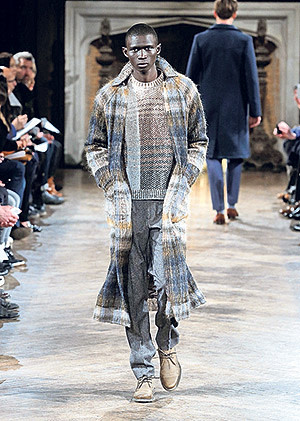New York Fashion Week: menswear shows

Simply sign up to the Life & Arts myFT Digest -- delivered directly to your inbox.
Bill de Blasio has spent his first month as New York mayor distinguishing himself from his predecessor Michael Bloomberg, casting himself as a man of the middle class, a champion of struggling families in a city that is home to plutocrats and hedge fund managers.
But what is an appropriate look to adopt in such a city? Last week, the small cohort of menswear designers in New York offered up some ideas.
Billy Reid, for example, showcased a range of outerwear and sharply tailored yet relaxed separates. A multicoloured wool plaid overcoat, with patches of olive, rust and camel looked luxurious (and warm); however, trousers in Argyle jacquard, grey tweed, a taupe-grey tartan and camel hair may be a hard sell until the first winter storm.
Public School, the label designed by duo Dao-Yi Chow & Maxwell Osborne, had a more alternative view: tailoring with a heavy sport influence and overdone layering, a style that helped win them the CFDA Vogue fashion fund last autumn. A herringbone double-breasted coat with specks of charcoal fell to the knee, paired with breezy loose-fitting cashmere pants that might win some fans in de Blasio’s Brooklyn neighbourhood, especially as it’s all manufactured in New York.
Todd Snyder offered an easier entry point, drawing on Bowie and the film Quadrophenia, but still grounded in Snyder’s signature preppiness. The designer’s collection was smartly tailored, particularly a charcoal-and-black plaid suit that hugged the chest but stepped away from the ultra-slim trousers that have been so popular over the past two years.
The same could not be said about J Crew’s popular suit line-up: lapels were slimmed, sleeves cut with narrow openings to give the arm more definition. The palette was also more forceful: its jet black two-button blazer seemed straight from Theory or Hugo Boss. Duckie Brown, meanwhile, was more languid, with proportions that were purposefully unkempt. A steel-blue silk evening coat with sleeves that billowed like a cape was striking, but lacked masculinity.
Robert Geller was more buttoned-up: cropped wool trousers with stripes of navy, burgundy and white down the front, alongside matching sports coats and jackets. Whether he started with an American in Paris or a Brit in Manhattan, you couldn’t quite tell, but the idea of a man out of place, in a foreign, brittle landscape, was conspicuous. Geller also worked with neoprene to good effect, while Tim Coppens, another fan of technical fabrics, went with Austrian Loden wools.

If that is not enough for de Blasio to put to rest the whispers that luxury runs counter to his tale of two cities, he should try Opening Ceremony. Retailers-cum-designers Humberto Leon and Carol Lim reused some of their ideas from last season: a structured wool coat in hunter green and oversized T-shirts in scarlet with zipper gussets at the bottom were fun.
Patrik Ervell, a designer who had his start in Leon and Lim’s stores, also played with shape. Ervell has carved out a niche in New York with sculptured pieces and odd fabrics. But last week his work fell a little flat, playing more collegiate than adult. A translucent white top of crinkled nylon provided an audible crunch when passing by.
That may be the point. De Blasio could choose a fine but simple suit elsewhere (perhaps from Ovadia & Sons, whose pine-green two-button number looked neat). But it would lack the movement that Ervell and Opening Ceremony are bringing to menswear. After all, didn’t de Blasio take office on the promise of change?
Comments